Proper Running Foot Strike: 3 Steps to Better Forefoot Running
Learn about the styles of running, proper running foot strike, and 3 steps to improve your forefoot running technique and stop heel striking.

Proper running foot strike doesn’t look the same on everyone, but it’s certainly not something that comes naturally. Does riding a bike come naturally? Does swimming come naturally?
No. So why should proper running?
As a lot of you know by now, running boils down to a lot more than just putting one foot in front of the other. Nutrition, training, and even your running foot strike all play an important part.
In this post, we tackle proper foot strike, styles of forefoot running, and 3 surefire steps to perfect your proper running form!
Running Foot Strike: Most Common Types Of Running Styles
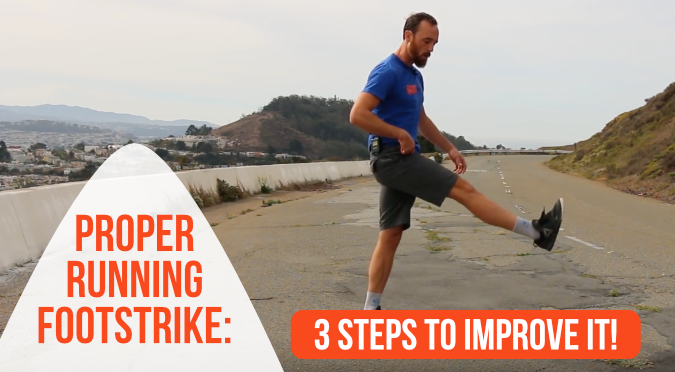
The way your foot hits the ground as you run tends to fall into one of three categories.
Before we get into what they are, let’s first make something very clear.
One isn’t better or worse than another.
There’s no one-form-fits-all proper running form foot strike—they are each valuable for some type of terrain, elevation change, the section of a race, etc.
Understanding when to use them, and how to blend them to find your most “neutral” foot strike for the long runs will be our key focus here. And proper foot strike is a crucial piece of good form in your running technique.
- Heel Strike
- Forefoot Strike
- Mid-Foot Strike
Heel Strike Running: Most Common Style
With this heel strike running method (also known as heel-to-toe running), the heel hits the ground before the rest of the foot follows suit to land. Heel strikers are common.
But what is heel-strike running? Good question.
This is one of the most common foot strikes we see, and here’s why:
- If you spend most of your day seated, you’ve probably developed chronically tight hips.
- Due to this, your stride reaches out much further in front of you than it needs to. This is also known as overstriding.
- You drive your running with your legs and feet, not your hips and glutes.
- The heel style strike is your best attempt at catching and continuing that stride from one leg to the next.
While we don’t encourage “defaulting” to the heel style strike out of poor running form (especially for longer runs), we do think it can be beneficial as a brake system on a downhill or sharp turn.
Utilizing this method in those instances can help minimize injury risk on downhills. Having said that, keep your stride length safe and reasonable as you navigate a descent.
Heel strike running isn’t necessarily running on your heels. Yes, your heels strike first, but that doesn’t mean you’re not using the rest of your foot.
If you find you’re defaulting to heel striking due to muscle imbalances and weaknesses rather than strategy, then we’ll show you how to stop heel striking further down in this article.
Forefoot Strike: Forefoot Running at Speed
You’ll find this type of foot strike (running toe to heel) on the opposite end of the spectrum.
What characterizes the forefoot style foot strike:
1) Running on balls of feet: Your weight is heavily focused on the ball of the foot and the toes.
2) Running on toes—not heels: Your heels are likely not hitting the ground between steps.
3) Bent forward: Your upper body may be a little bent forward from the hips.
Though spending an entire long run in this position would lead to tightness and cramps in the Achilles and calves, the forefoot style foot strike works well to kick up your speed and push off across a finish line or up a short hill. Consider it your gas pedal. Use it to live out your dreams of a sprinting finish.
There are a few different ways to forefoot strike:
- Running toe to heel: Landing on your forefoot and letting the rest of your foot collapse before taking off.
- Running on the balls of feet: Landing on the balls of your feet, and sometimes staying on the balls of your feet.
- Running on your toes: Landing on your toes and not letting your heel touch before taking off again.
Mid-foot Strike Running: Another Form of Forefoot Running
Ah, a happy medium, the mid-foot strike running. Not an over-stride, but not a forefoot strike either.
This is the most neutral foot strike of the three, and it’s how we could describe how your foot should land when running.
However, remember, everyone is different, and some bodies will be more comfortable with different running forms.
Most of your foot hits the ground at once, with your weight balanced right about even on top of your hips, knees, and ankles.
Though you’ll definitely want to utilize your new “brake” and “gas” pedals, you’ll want to find some version of this mid-foot style strike to use on the bulk of your longer runs. This is especially important for distance runners looking to stay injury-free. And really for all runners, this footstrike style should be a part of any jog.
Should You Switch to Forefoot Strike Running?
Forefoot striking is often associated with increased speed and efficiency but it’s not ideal for every runner. You'll want to consider your current running form, goals, and any previous injuries before you make any major changes.
Here’s how to determine if a forefoot strike might be right for you:
Forefoot strike running might help if you:
- Are a sprinter or middle-distance runner: These athletes often benefit from the quick, light steps facilitated by forefoot striking, which can lead to faster sprint times.
- Experience frequent injuries with heel striking: Some runners find that shifting to a forefoot strike reduces the stress on their knees and hips.
- Want to improve your running efficiency: Forefoot striking can increase your cadence and encourage a more efficient energy transfer throughout your running cycle.
However, transitioning to a forefoot strike should be approached with caution:
- Check your current form: It’s essential to understand your natural running form before making significant changes. Consider consulting with a running coach or a professional who can analyze your stride and offer personalized advice.
- Consider your shoe type: Forefoot striking often requires shoes with less cushioning in the heel and more flexibility in the forefoot. You might need to experiment with different types of running shoes to find the right fit for this style.
- Ease into it: Abruptly changing your running form can lead to injuries. Gradually introduce forefoot striking into your routine, starting with short distances and slowly building up as your body adapts.
How to Adopt a Forefoot Strike
Decided to adopt a forefoot running strike? Here's how to make the transition successfully:
- Start Small: Begin by incorporating forefoot strike into your warm-ups or short intervals during your regular runs. This gradual integration helps your muscles and joints adapt without overwhelming them.
- Strengthen Key Muscle Groups: Engage in exercises that strengthen your calves, ankles, and arches of your feet, as these areas are under more strain when you forefoot strike. Exercises like calf raises, toe curls, and foot doming can be particularly helpful.
- Improve Flexibility and Mobility: Since forefoot running can increase the load on your Achilles tendon and calves, it’s crucial to enhance the flexibility and mobility of these areas. Regular stretching and mobility exercises for your lower legs and feet are important.
- Monitor Your Progress: Keep an eye on how your body responds to the change. Look out for signs of strain or discomfort in your calves, Achilles, and feet. If you notice persistent pain, it might be worth reassessing whether forefoot striking is suitable for you.
- Get Professional Guidance: If possible, work with a running coach who can provide feedback on your technique and help you make adjustments as needed. This guidance can be invaluable in avoiding common pitfalls associated with transitioning to a new running form.
Tweak Your Running Posture
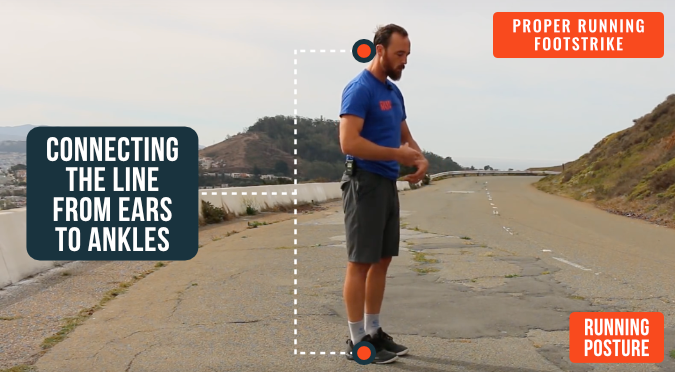
Picture this: the foot is at the end of a long kinetic whip.
The way the foot lands is a direct result of what your upper body and lower body are doing. What’s going on both above and below your center of gravity matters.
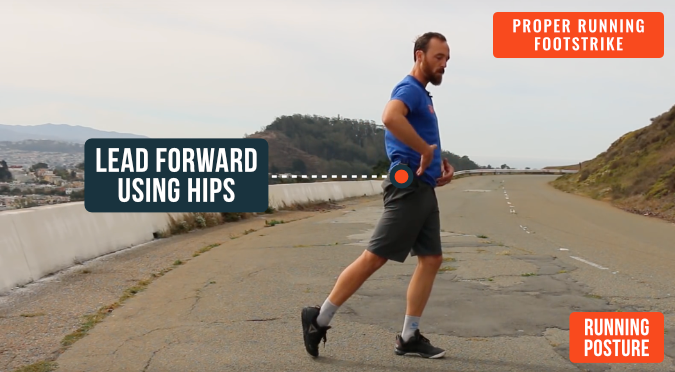
The only way it can respond properly is if your upper body posture supports it.
This means head stacked on top of shoulders, shoulders on top of hips, etc.
As a result, the hip flexors and glutes will be able to engage and push forward, allowing the stride to open as the leg swings back and cycles forward in one fluid motion. Core strength is an important ingredient here, necessary to keep the rest of the body in line. A strong core while running also minimizes risk of injury in your lower back.
Increasing your hip mobility and strengthening your glutes will help make this possible!
Fix Your Arm Swing
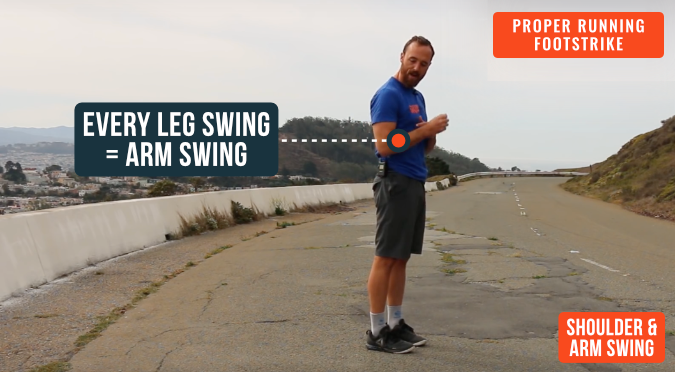
For every leg swing, there’s an arm swing, another key ingredient in proper form for your running gait.
This contralateral movement is what drives your running. Often new runners underestimate the importance of the arm swing, but it really does play a big role in good running form.
Improving the range of motion and power of your arm swing will inform the legs, creating an easier, more sustainable foot strike.
Relaxing the shoulders will increase the range of your arm swing and thus drive more power to your legs. Especially on uphills, your body might fall into a slight forward lean. Try to notice as this occurs, and keep your shoulders down and not rounded. Avoid slouching at all costs, and let your arms power you up the hill.
*Remember: arms swing front to back, not crossed in front of you!
Looking for more direction here? Check this out 🙂
Increase Your Cadence to Find Your Foot-Strike
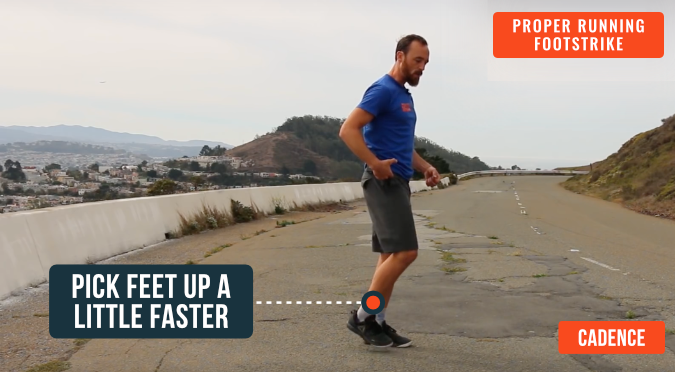
We all know what that “marathon shuffle” looks/feels like.
Putting a little pep in your step can spark a whole chain of improvements in your running form and, therefore, your foot strike! Increasing your cadence simply means increasing the number of steps you take per minute, thereby shortening your stride length.
For example, a stronger hip position allows you to pick your feet up off the ground faster. While it might seem counterintuitive, increasing your cadence improves distance running, not just speed running.
In turn, that increased cadence encourages the feet to relax and re-strike the ground in a more neutral, shock-absorbing manner. This is going to take some of the load off of the hamstrings, which can get irritated if you’re used to overstriding.
Think of it this way, the quicker you can get your landing foot off the ground, the lighter the load it had to bear in the first place. Increasing your cadence makes your overall running style lighter, reduces strain in the quads and hips, and therefore helps to reduce running injuries.
If you struggle to pick up the pace, use a treadmill to get your body used to shorter, quicker steps. Remember to focus on correct running form even as you increase your cadence. No need to get a personal trainer involved if you have no need, just look for some drills and workouts online to get your body used to quicker foot turnover.
How to Stop Heel Striking (and Guidance)
Remember, heel striking isn't necessarily bad. Sometimes, it's the right foot strike for runners with different characteristics. For example, different leg length, hip structure, and the like can influence whether a heel strike is more natural than a forefoot strike.
Heel striking often involves a longer stride with your foot landing ahead of your body, which can increase the impact on your knees and hips. Transitioning to a mid-foot or forefoot strike can help align your foot strike under your hips, reducing impact forces and promoting a more efficient transfer of energy.
However, if you've decide you want to stop heel striking, here's how to make it happen:
Gradual Transition
- Shorten Your Stride: Begin by focusing on shortening your stride length. This helps to align your foot landing directly under your center of gravity, rather than ahead of it. A shorter stride promotes landing on the mid-foot or forefoot rather than the heel.
- Increase Your Cadence: Increasing the number of steps you take per minute can naturally shorten your stride. Aim for a cadence around 170-180 steps per minute. Many runners find it helpful to use a metronome app during runs to maintain a consistent cadence.
- Lean From Your Ankles: Slight forward lean from the ankles (not the waist) can help shift your body weight forward, facilitating a mid-foot or forefoot strike. Ensure this lean is subtle and involves the entire body moving as a single unit.
- Focus on Your Foot Landing: Pay attention to how your feet land during a run. Try to land softly with the foot making initial contact with the ground on the outer mid-foot, then rolling inward to distribute the impact.
Strengthen and Mobilize
- Strengthen Your Lower Legs and Feet: Strengthening exercises for your calves, arches, and toes can build resilience in these areas, supporting a forefoot or mid-foot strike. Incorporate exercises like toe curls, heel walks, and calf raises into your routine.
- Improve Ankle Mobility: Adequate ankle dorsiflexion is crucial for transitioning away from heel striking. Work on your ankle mobility with exercises like ankle circles, dorsiflexion stretches, and using a foam roller to loosen tight calves.
- Core and Hip Strengthening: A strong core and hips help maintain proper alignment and balance, crucial for changing your foot strike. Include exercises like planks, bridges, and hip flexor stretches in your workouts.
Practical Drills
- Barefoot or Minimalist Running: Practice running barefoot or in minimalist shoes on a soft surface for short distances. This can naturally encourage a forefoot strike and strengthen the muscles in your feet and ankles.
- Running Drills: Incorporate specific running drills that emphasize forefoot striking, such as high knees, butt kicks, and skipping. These drills improve your neuromuscular coordination and help you get used to the new foot strike pattern.
- Video Feedback: Record yourself running to visually assess your foot strike and form. This can provide insights into your running mechanics and show progress over time.
Frequently Asked Questions (FAQs)
What are the best forefoot running shoes?
Here’s what to look for in the best running shoes for forefoot strikers. Certain shoe designs can get in the way of a smooth forefoot transition. The best forefoot running shoes will have a higher heel-to-toe drop that allows your foot to naturally transition from forefoot landing to push-off
What’s the best way to learn how to start forefoot running?
Practice. Try the tips we mentioned above, and film yourself why you’re doing it. Once you know what to look for, you’ll be able to notice any improvements you can make to your forefoot running form.
What if I experience forefoot pain running?
You may experience a little bit of discomfort if you go full-on forefoot running cold turkey. If you’re putting in the miles, ease into it. You’ll be engaging new muscles in slightly different ways, so give your body time to adapt. If you’re experiencing forefoot pain when running, cut back a bit and give your body time.
Heel strike vs forefoot strike running? What’s better?
One isn't necessarily better than the other—they’re two different kinds of running forms that both have a specific time and place to be best used.
How should your feet hit the ground when running?
It all depends on which style of running you’re using. If you’re forefoot running, then you’d want your forefoot to hit first. If you’re mid-foot running, you’d want the entirety of your foot to land at just about the same time. And if you’re heel striking, then your heel should land first and then smoothly transition to a toe take-off.
Proper Running Foot Strike: Putting It All Together
If you can make a change in these three areas, your feet will start to strike just beneath your hips. Not way out in front of you for your heels to deal with, and not behind you, for your toes and calves to support.
Forefoot running is just a single tool in your runner’s toolbelt. Couple that with a strategic heel strike (when appropriate), and you’ll be ready to tackle any terrain at any distance.
Understanding that the footstrike is directly related to the rest of your body’s running habits will make all the difference. Learn how to start forefoot running as soon as possible to add this style to your running arsenal.
Even if your new footstrike is heel or toe-dominant, it will likely be more comfortable and sustainable for those long runs.
